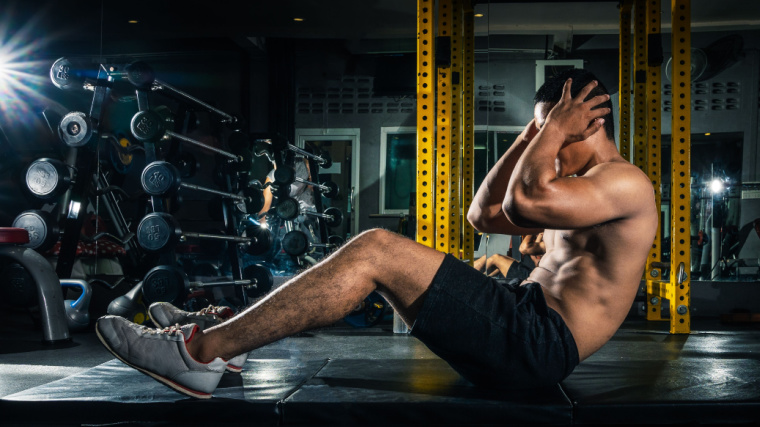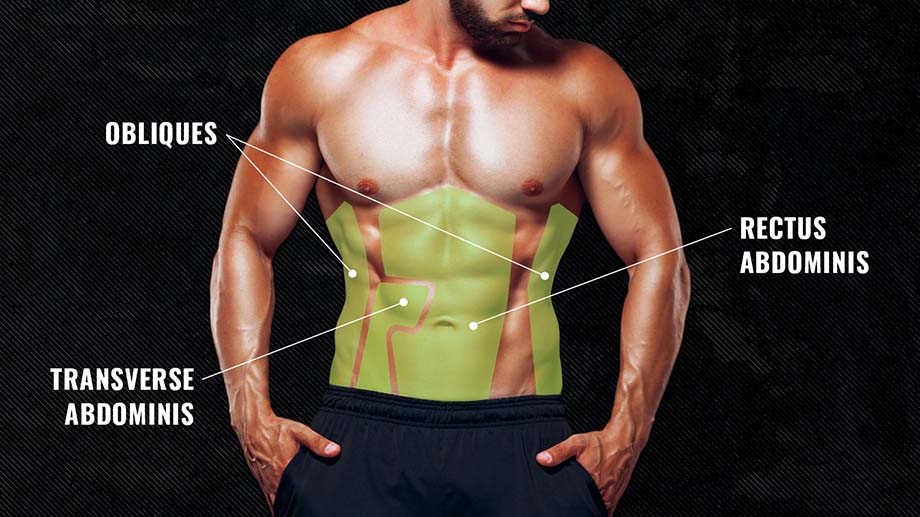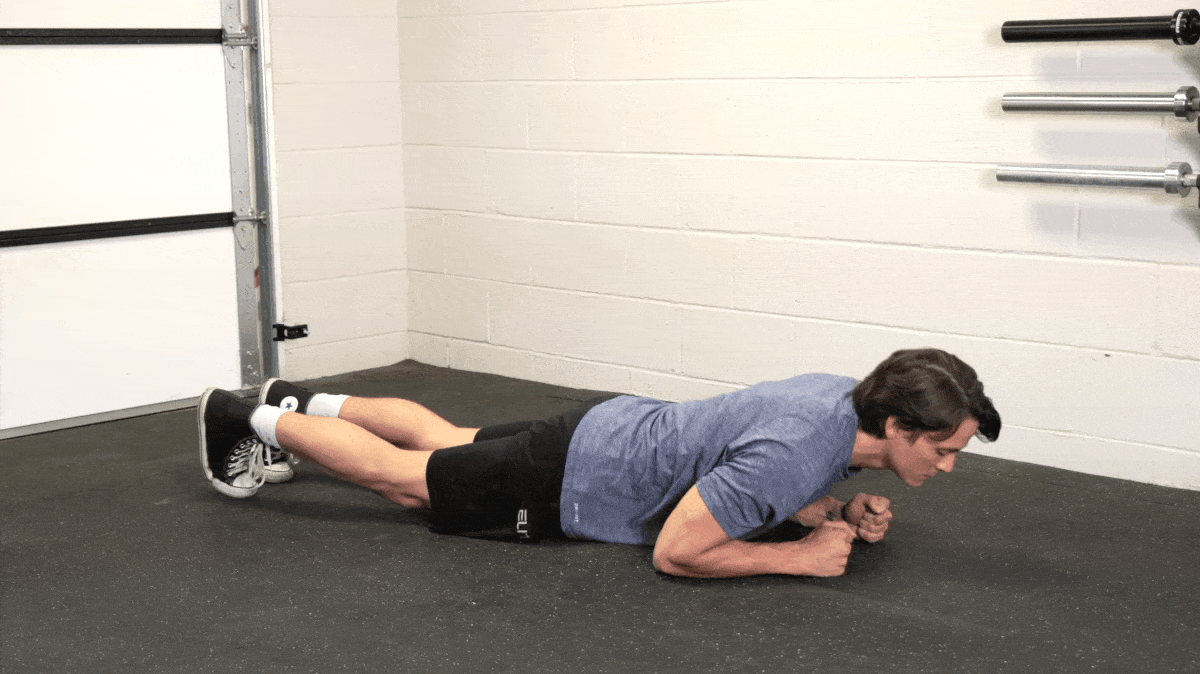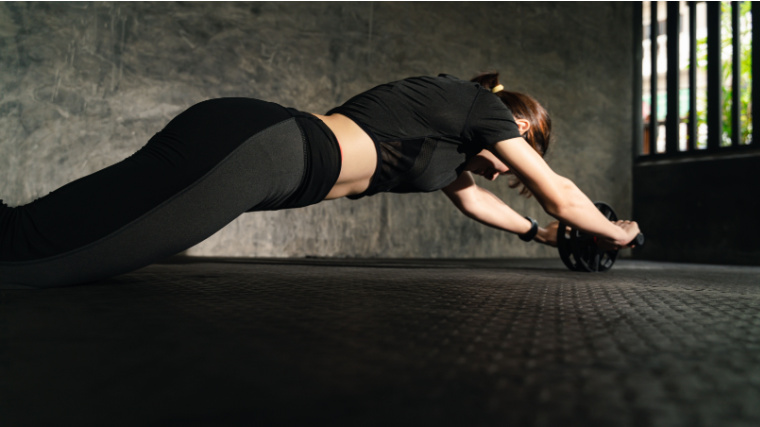The muscles that make up your abdominal region are good for a whole lot more than helping you look extra fit at the beach. In fact, your “six-pack” is just the tip of the iceberg. The muscles that encase your core and support your spine help you do everything from walk on the treadmill to pick up a 1-rep max deadlift.
Whether you want a shredded set of abs or just need to strengthen your core for your strength training workouts, the first and most important step is understanding the anatomy of your abdominal muscles. Once you’ve got the lay of the land, it’s time to carve them into a rock-solid six-pack.

Editor’s Note: The content on BarBend is meant to be informative in nature, but it should not be taken as medical advice. When starting a new training regimen and/or diet, it is always a good idea to consult with a trusted medical professional. We are not a medical resource. The opinions and articles on this site are not intended for use as diagnosis, prevention, and/or treatment of health problems. They are not substitutes for consulting a qualified medical professional.
Your Abdominal Muscles

Your abdominal muscles are responsible for more than you might think. The various muscles that enwrap your torso help you run, walk, jump, lift, carry … the list goes on. And if you want to train your abs properly, you need to know what the muscles actually do:
Rectus Abdominis
The rectus abdominis is your primary “six-pack” muscle. This sheet of tissue runs vertically down the front of your stomach and helps you bend your spine forwards.
- Where It Is: Originates on the front of your pubic bone and connects onto the cartilage of your ribcage.
- What It Does: Performs trunk flexion and assists with breathing patterns.
External Obliques
You can find your obliques running vertically along the sides of your torso. The obliques have two main compartments; the external obliques are the larger and more prominent of the two.
- Where It Is: Originates on your ribcage and inserts down on the crest of your pubic bone.
- What It Does: Primarily helps you rotate or tilt your torso from side to side, as well as resisting these movements.
Internal Obliques
For practical purposes, you can think of your internal and external obliques as the same muscle. Your internal obliques sit lower and deeper than their counterpart and perform many of the same functions.
- Where It Is: Begins on the iliac crest of the pelvis as well as the thoracolumbar fascia and connects onto the lower ribs.
- What It Does: Helps maintain intra-abdominal pressure and assists with trunk flexion and rotation.
Transverse Abdominis
Think of your transverse abdominis as the base layer of insulation for your core. This broad sheet of muscle sits under your rectus abdominis.
- Where It Is: Connects across the front of your ribcage down through your pelvis and pubic bone.
- What It Does: Contracts to assist with exhalation as well as side-to-side trunk rotation. Also helps maintain general tension within your abdominal cavity.
Best Abdominal Exercises
Ab training doesn’t have to be complicated, frustrating, or boring. It all starts with the movements you include in your workout. Set after set of floor crunches might numb the mind, but luckily there are far better options out there for maximizing your ab workouts. Here are a few of the best abdominal exercises you can do:
Overall — Cable Crunch
Your abdominals may have a variety of specialized duties, but they’re still a muscle group like any other. As such, the same principles that make any strength training movement worth your time (1) — a full range of motion, safety, and loadability — will apply to your abs as well. The cable crunch checks all those boxes.
[Read More: Real Life Functional Core Training]
- Set an adjustable cable station to eye level or slightly higher and fasten a rope or straight bar attachment to the carabiner.
- Grab the attachment and take a short step back from the cable to pull it taut, then get down into a kneeling position with the attachment held in front of your face.
- Maintain a loose grip on the attachment, exhale fully, and crunch your torso down toward the floor.
Bodyweight Only — Decline Reverse Crunch
It can easily feel like your abdominal muscles are meant to be trained exclusively with calisthenics (after all, the standard floor crunch is one of the first ab exercises most people will ever do). While that’s not necessarily true, the right bodyweight ab exercise can really go the distance.
The decline reverse crunch shines here, and for two reasons. First, it trains multiple core muscles at once through a full range of motion. Second, the exercise is hardest at the bottom when your abs are fully stretched out, and studies have shown that to be uniquely valuable for building muscle. (2)
[Read More: These Are 8 of the Best Lower Ab Exercises Out There, Seriously]
- Set an adjustable weight bench to a small-to-medium decline and lie down on your back with your feet on the floor.
- With your knees bent at 90 degrees, crunch your abs and lift your legs up in the air, using your abdominal muscles to push your feet up towards the ceiling.
- As you crunch, exhale and allow your lower back to press into the bench. When you lower your legs back down, arch your lower back to stretch your abs.
For Beginners — Plank
Ab training as a beginner is about more than just getting a good burn going. Your abdominal muscles are for more than just looking good; they’re the conduit through which you channel your muscular strength, power, agility, and other athletic qualities.
As such, as a beginner you need to know how to properly control and brace your abs, and there’s no better teacher than the standard front plank. For an added challenge, try the “long lever” plank, which has you place your arms further forward. This variation has been shown to create more abdominal engagement. (3)

[Read More: The Best Dumbbell Ab Workout for Every Experience Level]
- Get into a full kneeling position with your hands on the floor about shoulder width apart.
- Drop down and place your elbows on the ground directly under your shoulders.
- Extend your legs behind you and lock your knees with only the balls of your feet making contact with the floor.
- Exhale and contract your abs as though you’re bracing for a punch.
- Maintain a straight visual line from your shoulders to your ankles and hold that position.
For Back Health — The McGill “Big 3”
Training your abdominal muscles is an integral aspect of managing back pain. Dr. Stuart McGill is one of the world’s foremost experts in pain management, with over 30 years of experience as an educator and clinician.
McGill’s now-famous “Big 3” trio of ab exercises — the curl-up, side plank, and bird dog — zero in on the most essential functionality of your abs, maintaining good posture against resistance. These moves have real clinical support, too. One study (4) on core exercises asserts that “…incorporating the activation of distal trunk musculature would be optimal in terms of managing injury risk…” which is exactly what the McGill trio asks of you.
[Read More: The Best Bodybuilding Ab Workout for Your Experience Level]
For specific instructions on each element of the McGill Big 3, refer to the instructional video above.
Abdominal Training Tips
If you want to get the most value out of your ab workouts, you need to do more than just play things by the book. Keep these ab training tips in mind during your next core session to maximize your time in the gym:
Instability Is Overrated
When it comes to ab training, “unstable” surfaces like BOSU balls are somewhat overrated. The idea that exercising on a wobbly surface will force your core to work harder doesn’t really hold up when studied in a clinical setting (5):
“The current study did not demonstrate any advantage in utilizing the BOSU balance trainer … core exercises can be performed on stable ground without losing the potential core training benefits.” (6)
[Read More: The 15 Best Upper Ab Exercises for a Stronger Core]
That said, these pieces of equipment don’t appear to be significantly worse, either. It mostly comes down to preference and comfort — if doing ab exercises on an exercise ball is what you enjoy, you can certainly keep doing so.
Load, Load, Load
Your ab muscles work just like any other muscle group in your body when it comes to stimulations. Studies have shown a strong relationship between abdominal activation and external load — in short, more is generally better. (7)
[Read More: Try These Cable Ab Workouts to Crush Your Core]
With that in mind, strive to include some form of external load during your ab training so you can benefit from progressive overload. This can take the form of doing a machine crunch and gradually moving the peg down every week, holding a small dumbbell between your feet during leg raises, and so on.
Train Both Ends
Your abdominal muscles function to stabilize your torso. They accomplish this by attaching to both your ribcage and pelvis and controlling (or preventing) movement at those joints.

A well-designed ab workout should contain exercises that involve both spinal flexion and hip flexion; movement of the ribcage and pelvis, respectively. If you only perform crunch variations, you’re leaving some gains on the table. Be sure to perform both spinal flexion movements like crunches and hip flexion movements like leg raises during your ab workouts.
Work Laterally
No one muscle in your abdominal region works entirely in isolation. That said, muscles like your internal and external obliques are particularly well suited for producing and preventing rotational movement.
[Read More: The Best Ab Wheel Workouts You Can Do at Any Experience Level]
Consequently, a portion of your core training should contain side-to-side, unilateral, or anti-rotary exercises. The Russian twist, Pallof press, or side plank are good options here.
Your Takeaways
Ab training doesn’t need to be frustrating, complicated, or tedious. The best way to master your ab workouts is to go in with a comprehensive understanding of your own anatomy.
- Your abdominal region contains several important muscles including the rectus abdominis, internal and external obliques, and transverse abdominis.
- Most of these muscles control or assist with bending and rotating your spine or flexing your hip.
- Proper ab training involves exercises that work both your ribcage and pelvis and, ideally, can be progressively loaded over time.
More Training Content
- The Best Arm Exercises to Add to Your Workout Routine
- How to Gain Weight Fast (and Safely), According to Science
- How to Make the Ultimate Weekly Workout Schedule
References
- Schoenfeld B. J. (2010). The mechanisms of muscle hypertrophy and their application to resistance training. Journal of strength and conditioning research, 24(10), 2857–2872.
- Pedrosa, G. F., Lima, F. V., Schoenfeld, B. J., Lacerda, L. T., Simões, M. G., Pereira, M. R., Diniz, R. C. R., & Chagas, M. H. (2022). Partial range of motion training elicits favorable improvements in muscular adaptations when carried out at long muscle lengths. European journal of sport science, 22(8), 1250–1260.
- Schoenfeld, B. J., Contreras, B., Tiryaki-Sonmez, G., Willardson, J. M., & Fontana, F. (2014). An electromyographic comparison of a modified version of the plank with a long lever and posterior tilt versus the traditional plank exercise. Sports biomechanics, 13(3), 296–306.
- Gottschall, J. S., Mills, J., & Hastings, B. (2013). Integration core exercises elicit greater muscle activation than isolation exercises. Journal of strength and conditioning research, 27(3), 590–596.
- Saeterbakken, A. H., Andersen, V., Jansson, J., Kvellestad, A. C., & Fimland, M. S. (2014). Effects of BOSU ball(s) during sit-ups with body weight and added resistance on core muscle activation. Journal of strength and conditioning research, 28(12), 3515–3522.
- Willardson, J. M., Fontana, F. E., & Bressel, E. (2009). Effect of surface stability on core muscle activity for dynamic resistance exercises. International journal of sports physiology and performance, 4(1), 97–109.
- Moraes, A. C., Pinto, R. S., Valamatos, M. J., Valamatos, M. J., Pezarat-Correia, P. L., Okano, A. H., Santos, P. M., & Cabri, J. M. (2009). EMG activation of abdominal muscles in the crunch exercise performed with different external loads. Physical therapy in sport : official journal of the Association of Chartered Physiotherapists in Sports Medicine, 10(2), 57–62.
The post Your Abdominal Muscles, Explained (and How To Train Them) appeared first on BarBend.

